
Gewürztraminer is an aromatic wine grape variety, used in white wines, and which performs best in cooler climates. In English, it is sometimes referred to colloquially as Gewürz. In English and French it is usually written Gewurztraminer. Gewürztraminer is a variety with a pink to red skin colour, which makes it a "white wine grape" as opposed to the blue to black-skinned varieties commonly referred to as "red wine grapes". The variety has high natural sugar and the wines are white and usually off-dry, with a flamboyant bouquet of lychees. Indeed, Gewürztraminer and lychees share the same aroma compounds. Dry Gewürztraminers may also have aromas of roses, passion fruit and floral notes. It is not uncommon to notice some spritz.

Chasselas or Chasselas blanc is a wine grape variety grown mainly in Switzerland, France, Germany, Portugal, Hungary, Romania, New Zealand, Croatia and Chile. Chasselas is mostly vinified to be a full, dry and fruity white wine. It is also suitable as a table grape, grown widely for this purpose in Turkey and Hungary.

The Muscat family of grapes includes over 200 grape varieties belonging to the Vitis vinifera species that have been used in wine production and as raisin and table grapes around the globe for many centuries. Their colors range from white, to yellow, to pink to near black. Muscat grapes and wines almost always have a pronounced floral aroma. The breadth and number of varieties of Muscat suggest that it is perhaps the oldest domesticated grape variety, and there are theories that most families within the Vitis vinifera grape variety are descended from the Muscat variety.

Aligoté is a white grape used to make dry white wines, especially in the Burgundy region of France where it was first recorded in the 18th century. Since it is tolerant to cold, this variety is also cultivated in Eastern European countries. In 2004, it was the 22nd most planted vine variety in the world at 45,000 hectares.
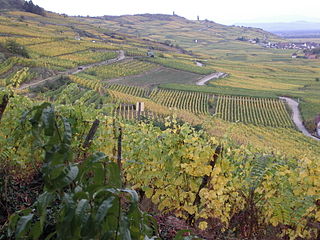
Alsace wine or Alsatian wine is produced in the Alsace region in France and is primarily white wine. Because of its Germanic influence, it is the only Appellation d'Origine Contrôlée region in France to produce mostly varietal wines, typically from similar grape varieties to those used in German wine. Along with Austria and Germany, it produces some of the most noted dry Rieslings in the world as well as highly aromatic Gewürztraminer wines. Wines are produced under three different AOCs: Alsace AOC for white, rosé and red wines, Alsace Grand Cru AOC for white wines from certain classified vineyards and Crémant d'Alsace AOC for sparkling wines. Both dry and sweet white wines are produced.
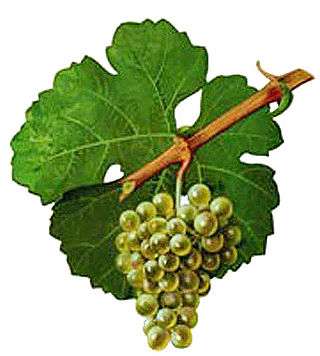
Silvaner or Sylvaner is a variety of white wine grape grown primarily in Alsace and Germany, where its official name is Grüner Silvaner. While the Alsatian versions have primarily been considered simpler wines, it was included among the varieties that can be used to produce Alsace Grand Cru wine in 2006, together with the four 'noble grapes' of Alsace, although only in one vineyard, Zotzenberg.

Saracena is a town and comune in the province of Cosenza in the Calabria region of southern Italy. The town is bordered by Altomonte, Castrovillari, Firmo, Lungro, Morano Calabro, Mormanno, Orsomarso and San Basile and is home to the Church of San Leone, a 12th-century Byzantine church. The town's patron is San Leone di Catania, who is celebrated twice a year, once in the spring, then again in late summer.

Black Muscat is a red Vitis vinifera grape variety derived from the crossing of the Schiava Grossa and Muscat of Alexandria by Seward Snow, Head Gardener to Earl de Grey at Wrest Park, Bedfordshire UK in 1850, according to the Vitis International Variety Catalogue. It is known under a variety of local names such as Golden Hamburg, and Black Hamburg in the US; Muscat de Hambourg in France; Moscato di Amburgo in Italy; and Muscat Gamburgskiy in Russia and former Soviet Union countries. Confusingly, Black Hamburg is also used as a synonym for its maternal parent. It is commonly produced as table wine but in California's Central Valley it has been used in the production of dessert wine. As a dessert wine it can be highly aromatic with a rich coloring. In the US it is grown in wine appellations in California, Virginia, Oregon, Texas, and Washington. In Canada, it is also found on Vancouver Island.
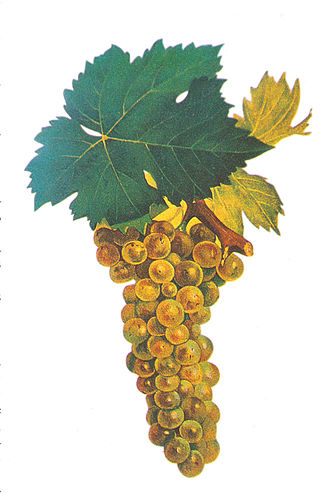
Muscat Blanc à Petits Grains is a white wine grape of Greek origin that is a member of the Muscat family of Vitis vinifera. Its name comes from its characteristic small berry size and tight clusters. It is known under a variety of local names such as Moscato bianco, Muscat blanc, Muscat Canelli, Muscat de Frontignan, Muscat de Lunel, Muscat d'Alsace, Muskateller, Moscatel de Grano Menudo, Moscatel rosé and Sárgamuskotály.

Aleatico is a red Italian wine grape variety. It is notable for being the primary grape in the cult wine Aleatico di Portoferraio made in Elba. In Chile is known as Red Moscatel. The grape has also been cultivated at Mudgee in New South Wales and California.
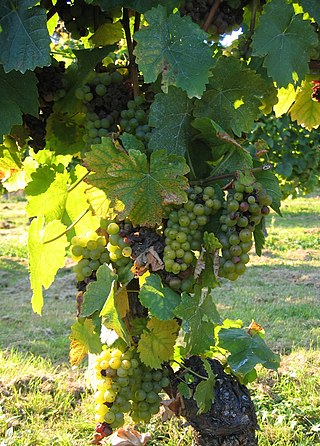
Morio Muscat is a white wine grape that was created by viticulturalist Peter Morio at the Geilweilerhof Institute for Grape Breeding in the Palatinate in 1928. He claimed to have crossed the varieties Silvaner and Pinot blanc, but based on the variety's properties it has been speculated that he actually crossed Silvaner and Muscat Blanc à Petits Grains. But so far this speculation has yet to be conclusively proven. The grape is highly aromatic with a "grapey" characteristic reminiscent of Muscat grape varieties. The grape is rarely used for varietal wines because it requires a high level of ripeness to avoid producing wine with a "mousey" flavor, a coarse texture and overabundance of acidity.

Moscato Giallo or Yellow Muscat is a white Italian wine grape variety that is a member of the Muscat family of grapes. Known for its large deep cluster of loose, deep-yellow berries and golden colored wine, Moscato Giallo is grown mostly in northern Italy where it is most often used to produce passito style dessert wines. The grape is also planted in Croatia where it is known as Muškat žuti.

Bouvier is a white wine grape and table grape planted primarily in Central Europe—most notably in Austria, Hungary, Slovakia and Slovenia, where it is also known as Ranina.
Terret blanc is a white French wine grape variety growing primarily in the Languedoc-Roussillon region of southern France. It is a mutation of the Terret vine that also spawned the dark skinned Terret noir and light-skinned Terret gris varieties.
Muscat Rose à Petits Grains is a wine grape for white wine that is a member of the Muscat family of Vitis vinifera. Its name comes from its characteristic small berry size and tight clusters, and from its skin colour. It's a variation of the more common Muscat Blanc à Petits Grains with a pinkish colour. Muscat Rouge à Petits Grains is a further variation with deeper skin colour.
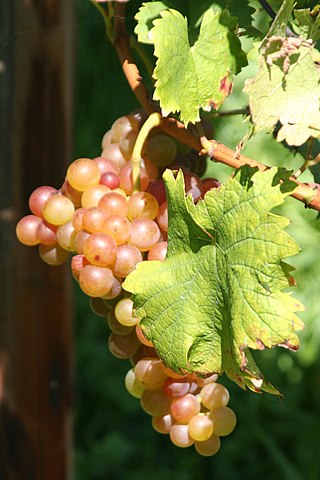
Muscat Rouge à Petits Grains is a wine grape for white wine that is a member of the Muscat family of Vitis vinifera. Its name comes from its characteristic small berry size and tight clusters, and from its skin colour. It's a variation of the more common Muscat Blanc à Petits Grains with a reddish colour, which in some of its synonyms are described as brown, gray or violet. Muscat Rose à Petits Grains is a further variation with lighter, pinkish skin colour.

Incrocio Manzoni or Manzoni grapes is a family of grape varieties named after Professor Luigi Manzoni (1888-1968) of Italy's oldest school of oenology located in Conegliano, in the Veneto region. Manzoni created the new grape varieties by selecting, crossing and grafting vines from various vineyards during the 1920s and 1930s. The family includes both white and red grape varieties. Although most Manzonis are grown in northeastern Italy, they are mainly grown in the Piave area of Province of Treviso and are only now starting to be sold commercially in Europe and the United States.
Mornen noir is a red French wine grape variety that was historically grown in both the Rhône and Loire departments but is today only found in very limited plantings around the commune of Chavanay.
Addoraca is a white Italian wine grape variety that is grown in the Calabria region of southern Italy where it is blended with Coda di Volpe bianca, Malvasia bianca di Candia and Muscat blanc à Petits Grains in the passito dessert wine Moscato di Saracena.















